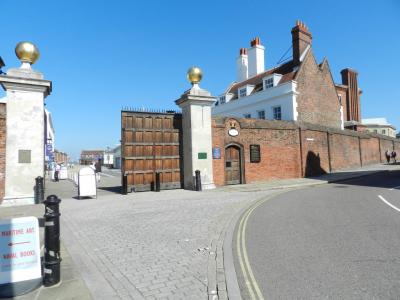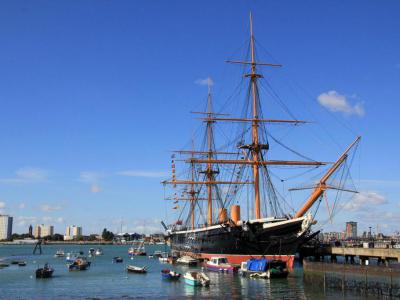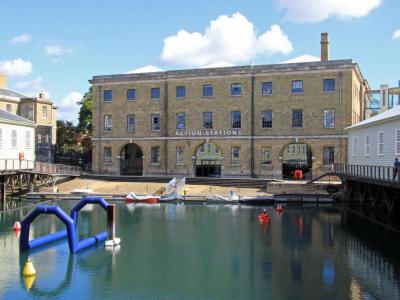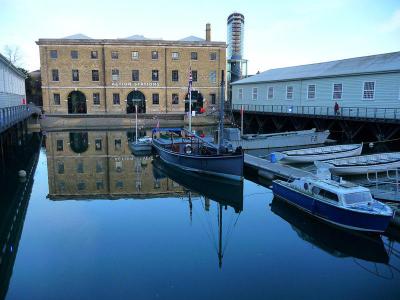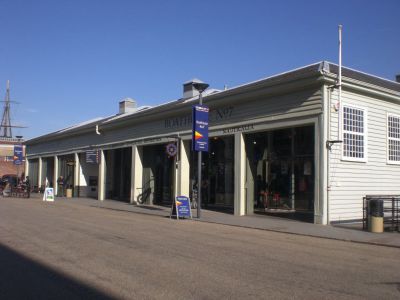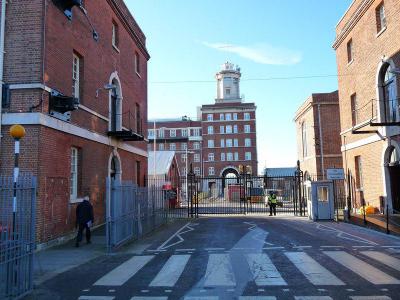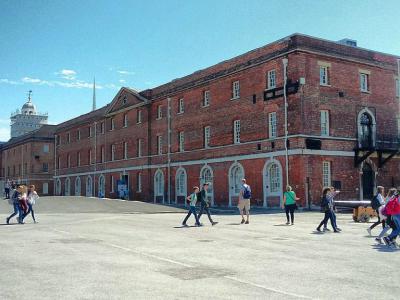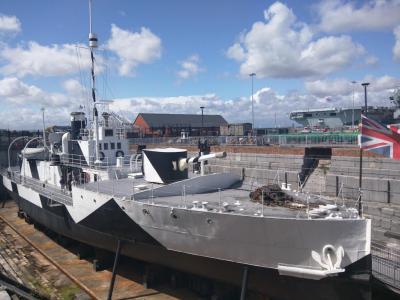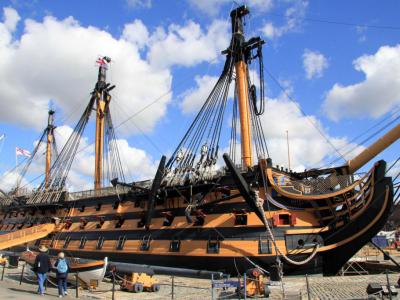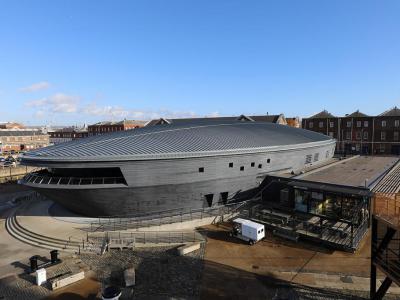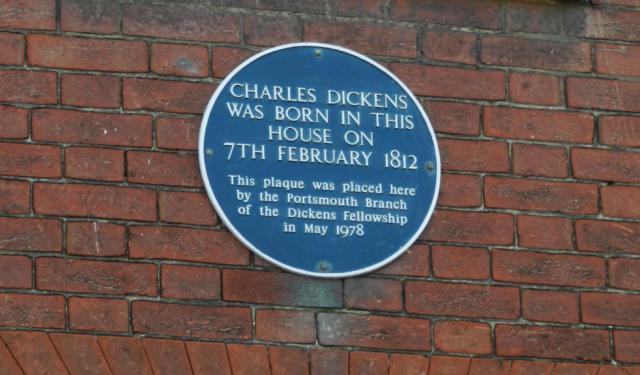Historical Dockyard Tour (Self Guided), Portsmouth
The naval theme has always been dominant for Portsmouth. Most of the city's historic events are in one way or another associated with its seaside location. Portsmouth's Historical Dockyard is the area that offers a glimpse into the city's maritime past.
The very first notable landmark here is Victory Gate, the dockyard's main entrance. Inside, visitors will find HMS Warrior, a magnificent iron-hulled warship from the 19th century, and Action Stations, an interactive museum showcasing modern naval technology. The Mast Pond is another intriguing feature, historically used for repairing and maintaining ships' masts.
Visitors can also explore the Dockyard Apprentice and Nauticalia Shop to purchase souvenirs and maritime-themed items. The Semaphore Tower stands tall as a reminder of communication methods used in the past. For those interested in delving deeper into naval history, the Royal Naval Museum offers a wealth of information and artifacts.
The dockyard is also home to HMS M33, a historic battleship, and the iconic HMS Victory, Lord Nelson's flagship from the Battle of Trafalgar. Lastly, one shouldn't miss the Mary Rose Museum, which showcases the remains of the famous Tudor warship.
Overall, the Historical Dockyard of Portsmouth is a must-visit destination for anyone interested in uncovering some of the secrets of Britain's maritime legacy. The available range of attractions suitable for all ages here promises a truly unforgettable experience. So, plan your visit today and set sail on a journey through history!
The very first notable landmark here is Victory Gate, the dockyard's main entrance. Inside, visitors will find HMS Warrior, a magnificent iron-hulled warship from the 19th century, and Action Stations, an interactive museum showcasing modern naval technology. The Mast Pond is another intriguing feature, historically used for repairing and maintaining ships' masts.
Visitors can also explore the Dockyard Apprentice and Nauticalia Shop to purchase souvenirs and maritime-themed items. The Semaphore Tower stands tall as a reminder of communication methods used in the past. For those interested in delving deeper into naval history, the Royal Naval Museum offers a wealth of information and artifacts.
The dockyard is also home to HMS M33, a historic battleship, and the iconic HMS Victory, Lord Nelson's flagship from the Battle of Trafalgar. Lastly, one shouldn't miss the Mary Rose Museum, which showcases the remains of the famous Tudor warship.
Overall, the Historical Dockyard of Portsmouth is a must-visit destination for anyone interested in uncovering some of the secrets of Britain's maritime legacy. The available range of attractions suitable for all ages here promises a truly unforgettable experience. So, plan your visit today and set sail on a journey through history!
How it works: Download the app "GPSmyCity: Walks in 1K+ Cities" from Apple App Store or Google Play Store to your mobile phone or tablet. The app turns your mobile device into a personal tour guide and its built-in GPS navigation functions guide you from one tour stop to next. The app works offline, so no data plan is needed when traveling abroad.
Historical Dockyard Tour Map
Guide Name: Historical Dockyard Tour
Guide Location: England » Portsmouth (See other walking tours in Portsmouth)
Guide Type: Self-guided Walking Tour (Sightseeing)
# of Attractions: 10
Tour Duration: 1 Hour(s)
Travel Distance: 0.4 Km or 0.2 Miles
Author: Lilly
Sight(s) Featured in This Guide:
Guide Location: England » Portsmouth (See other walking tours in Portsmouth)
Guide Type: Self-guided Walking Tour (Sightseeing)
# of Attractions: 10
Tour Duration: 1 Hour(s)
Travel Distance: 0.4 Km or 0.2 Miles
Author: Lilly
Sight(s) Featured in This Guide:
- Victory Gate
- HMS Warrior
- Action Stations
- Mast Pond
- Dockyard Apprentice and Nauticalia Shop
- Semaphore Tower
- The National Museum of the Royal Navy
- HMS M33 - Battle Ship
- HMS Victory
- Mary Rose Museum
1) Victory Gate
Victory Gate marks the grand historic entrance to the Portsmouth Historic Dockyard-a site where over 500 years of naval heritage come to life. Dating from the early 18th century, this Grade II listed gateway stands on the foundations of earlier quay structures and was formally rebuilt in 1902 using elements from its predecessor, blending red brick, stone piers, and golden ‘ball-on-cushion’ finials.
A visit to Victory Gate is more than a photo opportunity-it’s the threshold to a world of maritime marvels. Just beyond lies the HMS Victory, the legendary flagship of Admiral Nelson, along with HMS Warrior, the Mary Rose Museum, and other fascinating naval exhibits. Though the gate itself no longer functions as a security checkpoint, it remains a powerful symbol of Portsmouth’s naval identity and invites you to start your journey through centuries of seafaring valor.
A visit to Victory Gate is more than a photo opportunity-it’s the threshold to a world of maritime marvels. Just beyond lies the HMS Victory, the legendary flagship of Admiral Nelson, along with HMS Warrior, the Mary Rose Museum, and other fascinating naval exhibits. Though the gate itself no longer functions as a security checkpoint, it remains a powerful symbol of Portsmouth’s naval identity and invites you to start your journey through centuries of seafaring valor.
2) HMS Warrior (must see)
The HMS Warrior was the biggest, fastest, and most powerful warship of her kind when she was launched in 1860. She was years ahead of the American Merrimack and Monitor, way rapid and more seaworthy. The Warrior was Britain's first iron-hulled, armored warship, offering protection from explosive shells. She was a worldwide game-changer.
Intimidating as she was, she never fired an angry shot. Invincible she may have been, her active duty career was short. Soon she was absolete and quickly outclassed by newer ships, faster with thicker armor and heavier guns. In 1871, the Warrior was downgraded to reserve status. In 1924 she was up for sale as scrap.
The Warrior wasn't scrapped but converted into a floating oil tank at Pembroke Dock. The oil depot closed in 1978, and the ship underwent restoration by the Maritime Trust. In 1987 the Warrior returned to Portsmouth Harbour. Saved from the knackers, she is now a proud ship museum and a naval monument.
A complete conservation and restoration program, costing upward of 4.2 million pounds, was completed in 2019. The Warrior is now represented as she was in her Round-Britain Tour of 1863.
Intimidating as she was, she never fired an angry shot. Invincible she may have been, her active duty career was short. Soon she was absolete and quickly outclassed by newer ships, faster with thicker armor and heavier guns. In 1871, the Warrior was downgraded to reserve status. In 1924 she was up for sale as scrap.
The Warrior wasn't scrapped but converted into a floating oil tank at Pembroke Dock. The oil depot closed in 1978, and the ship underwent restoration by the Maritime Trust. In 1987 the Warrior returned to Portsmouth Harbour. Saved from the knackers, she is now a proud ship museum and a naval monument.
A complete conservation and restoration program, costing upward of 4.2 million pounds, was completed in 2019. The Warrior is now represented as she was in her Round-Britain Tour of 1863.
3) Action Stations
Action Stations is a dynamic high-energy attraction, designed to immerse visitors in the exhilarating world of Royal Navy and Royal Marines operations. This indoor adventure mixes physical challenges, cutting-edge simulators, and family-friendly entertainment.
You can scale one of the tallest indoor climbing walls in the UK or take on the high-energy Ocean Warrior assault course. Younger children can enjoy the fun of the Sky Tykes rope course, while older kids and adults push their limits on Commando-style obstacle challenges designed to mimic real-life training scenarios.
Beyond physical feats, Action Stations also offers tech-savvy attractions such as flight simulators, periscope views of naval vessels, and interactive navigation exhibits that offer insight into modern naval tactics and technology. For laser tag fans, Laser Quest adds an extra dimension of competitive fun.
You can scale one of the tallest indoor climbing walls in the UK or take on the high-energy Ocean Warrior assault course. Younger children can enjoy the fun of the Sky Tykes rope course, while older kids and adults push their limits on Commando-style obstacle challenges designed to mimic real-life training scenarios.
Beyond physical feats, Action Stations also offers tech-savvy attractions such as flight simulators, periscope views of naval vessels, and interactive navigation exhibits that offer insight into modern naval tactics and technology. For laser tag fans, Laser Quest adds an extra dimension of competitive fun.
4) Mast Pond
The Mast Pond is a fascinating glimpse into 17th-century naval engineering and maritime preservation. Dug in 1665 by dockyard labourers and Dutch prisoners of war, this saltwater basin was used to soak timber-especially long masts-for ships, helping prevent splitting and rot before installation on Royal Navy vessels. Today, it remains not only a Scheduled Monument and Grade I listed structure, but also a scenic focal point amid the Historic Dockyard landscape.
Set alongside historic boathouses and bordered by water-level buildings, the Mast Pond is linked to Portsmouth Harbour via an underground tunnel beneath the road. While the original lock-gate system has been replaced with modern hydraulic gates in 2000, it continues to regulate water levels, preserving both monument and function. Its age and setting make it the oldest surviving water-based structure in the Dockyard complex.
Today, the Mast Pond serves a new purpose: it houses a flotilla of restored historic boats maintained by the Portsmouth Dockyard Historical Trust. Visitors can admire vessels such as WWI rowing launches, pinnaces, and powerboats moored here, offering a vivid, living link between the Dockyard’s working past and its cultural heritage.
Set alongside historic boathouses and bordered by water-level buildings, the Mast Pond is linked to Portsmouth Harbour via an underground tunnel beneath the road. While the original lock-gate system has been replaced with modern hydraulic gates in 2000, it continues to regulate water levels, preserving both monument and function. Its age and setting make it the oldest surviving water-based structure in the Dockyard complex.
Today, the Mast Pond serves a new purpose: it houses a flotilla of restored historic boats maintained by the Portsmouth Dockyard Historical Trust. Visitors can admire vessels such as WWI rowing launches, pinnaces, and powerboats moored here, offering a vivid, living link between the Dockyard’s working past and its cultural heritage.
5) Dockyard Apprentice and Nauticalia Shop
The Dockyard Apprentice & Nauticalia Shop offers a fascinating combination of living maritime heritage and shopping delight. Originally built in 1807 as a mast house, was carefully restored in the 1990s and now serves a triple purpose: it hosts a restaurant, an interactive exhibition about civilian dockyard life, and the Nauticalia shop full of seafaring treasures.
Step inside the Dockyard Apprentice Exhibition, where immersive displays and life-like mannequins bring to life the world of early 20th-century shipwrights and apprentices. Get hands-on with authentic tools, learn traditional knottyard skills, and trace Portsmouth’s crucial role in the making of Dreadnought-class battleships.
Adjacent lies Nauticalia, a purser’s store turned boutique specialising in maritime-themed gifts, from brass binnacles and ship’s bells to diving-helmet replicas and stylish nautical décor. Many items are handcrafted or reproduce 19th-century originals, reflecting Britain’s proud shipbuilding legacy.
Step inside the Dockyard Apprentice Exhibition, where immersive displays and life-like mannequins bring to life the world of early 20th-century shipwrights and apprentices. Get hands-on with authentic tools, learn traditional knottyard skills, and trace Portsmouth’s crucial role in the making of Dreadnought-class battleships.
Adjacent lies Nauticalia, a purser’s store turned boutique specialising in maritime-themed gifts, from brass binnacles and ship’s bells to diving-helmet replicas and stylish nautical décor. Many items are handcrafted or reproduce 19th-century originals, reflecting Britain’s proud shipbuilding legacy.
6) Semaphore Tower
The Semaphore Tower served as the terminus of Britain’s early line-of-sight naval communications. Built around 1831–33 atop the former Rigging House and Sail Loft, it was a crucial part of the Admiralty’s semaphore network, relaying messages from London to the fleet-typically in mere minutes-before giving way to more modern electric telegraph systems by 1847.
Constructed in stately red brick with an elegant octagonal top lantern, the tower incorporated the relocated Lion Gate arch from the old Portsea town wall in 1929, seamlessly merging dockyard architecture with Georgian grandeur and military history. Despite suffering a major fire in 1913, it was rebuilt and today functions as the offices of the Naval Base Commander and Queen’s Harbour Master.
Though not open for interior visits, its grandeur is best appreciated from the outside-especially from the boardwalk at Spice Island or the promenade near Gunwharf Quays. There, you can admire the sandstone lantern, flagstaff, and commanding views over the harbour.
Constructed in stately red brick with an elegant octagonal top lantern, the tower incorporated the relocated Lion Gate arch from the old Portsea town wall in 1929, seamlessly merging dockyard architecture with Georgian grandeur and military history. Despite suffering a major fire in 1913, it was rebuilt and today functions as the offices of the Naval Base Commander and Queen’s Harbour Master.
Though not open for interior visits, its grandeur is best appreciated from the outside-especially from the boardwalk at Spice Island or the promenade near Gunwharf Quays. There, you can admire the sandstone lantern, flagstaff, and commanding views over the harbour.
7) The National Museum of the Royal Navy
The National Museum of the Royal Navy is a treasure trove for anyone captivated by Britain’s maritime heritage. Located within the original HM Naval Base storehouses dating back to the 18th century and featuring the modern Victory Gallery, the museum offers visitors a richly layered journey through naval history. Its history stretches back to 1911 as the Royal Naval Museum, evolving into today’s national museum with a renaming in 2010 to reflect its broader mission.
Visitors can explore six carefully curated galleries. Among them, the Nelson Gallery illuminates the life and enduring legacy of Admiral Lord Nelson through personal artifacts and compelling narratives. The Hear My Story gallery offers a human perspective-sharing firsthand accounts from sailors and naval personnel over the past century. Meanwhile, Worlds Beneath the Waves immerses you in naval exploration, from the HMS Challenger scientific mission to modern deep-sea advancements.
A highlight for many is the opportunity to board iconic vessels tethered at the Dockyard. Step aboard HMS Victory, Nelson’s flagship at Trafalgar and the world's oldest commissioned warship, and explore its decks and restored Victory Gallery. Just steps away, HMS Warrior, the first iron-hulled warship, and HMS M33, one of only three surviving Royal Navy WWI monitor ships, bring different eras of naval engineering vividly to life.
Visitors can explore six carefully curated galleries. Among them, the Nelson Gallery illuminates the life and enduring legacy of Admiral Lord Nelson through personal artifacts and compelling narratives. The Hear My Story gallery offers a human perspective-sharing firsthand accounts from sailors and naval personnel over the past century. Meanwhile, Worlds Beneath the Waves immerses you in naval exploration, from the HMS Challenger scientific mission to modern deep-sea advancements.
A highlight for many is the opportunity to board iconic vessels tethered at the Dockyard. Step aboard HMS Victory, Nelson’s flagship at Trafalgar and the world's oldest commissioned warship, and explore its decks and restored Victory Gallery. Just steps away, HMS Warrior, the first iron-hulled warship, and HMS M33, one of only three surviving Royal Navy WWI monitor ships, bring different eras of naval engineering vividly to life.
8) HMS M33 - Battle Ship
HMS M33 is a remarkable slice of naval history-in fact, it’s one of only three surviving Royal Navy warships from World War I and the only Allied ship that took part in the Gallipoli Campaign still preserved today. Built in just a few months in 1915, this 580-ton monitor was designed for coastal bombardment, able to navigate shallow waters and bring its two 6-inch guns to bear close to enemy shores.
It earned a reputation as the “Lucky Ship”, returning unscathed from the Dardanelles and seeing action again in the Russian Civil War. Now on display at Portsmouth Historic Dockyard in a dry dock beside HMS Victory, HMS M33 has been conscientiously restored to its World War I configuration, complete with its iconic dazzle camouflage.
Visitors can explore the cramped decks, officer cabins, galley, mess, and even descend into the lower magazines to see original stores and untouched internal spaces. Audio-visual exhibits and immersive displays bring the ship’s storied past vividly to life.
Aboard HMS M33 you’ll step into the shoes of the 72 officers and men who served in its tight confines-many of whom came from varied civilian backgrounds like clerks, laborers, or butchers. Learn how the vessel supported landings at Suvla Bay, served in the Mediterranean and the Aegean, and later supported Allied forces on the River Dvina in northern Russia. Despite facing enemy fire multiple times, the ship remarkably suffered zero casualties-underscoring its legendary status.
It earned a reputation as the “Lucky Ship”, returning unscathed from the Dardanelles and seeing action again in the Russian Civil War. Now on display at Portsmouth Historic Dockyard in a dry dock beside HMS Victory, HMS M33 has been conscientiously restored to its World War I configuration, complete with its iconic dazzle camouflage.
Visitors can explore the cramped decks, officer cabins, galley, mess, and even descend into the lower magazines to see original stores and untouched internal spaces. Audio-visual exhibits and immersive displays bring the ship’s storied past vividly to life.
Aboard HMS M33 you’ll step into the shoes of the 72 officers and men who served in its tight confines-many of whom came from varied civilian backgrounds like clerks, laborers, or butchers. Learn how the vessel supported landings at Suvla Bay, served in the Mediterranean and the Aegean, and later supported Allied forces on the River Dvina in northern Russia. Despite facing enemy fire multiple times, the ship remarkably suffered zero casualties-underscoring its legendary status.
9) HMS Victory (must see)
Six ships were called HMS Victory. The first was a 42-gun vessel, demolished in 1609; the second was another 42-gunner, broken up in 1691; the third was a 100-gun first-rate, burned in 1721; the fourth was also a 100-gun first-rate, wrecked in 1744; the fifth was an 8-gun schooner in Canada and burned in 1768.
The sixth is Admiral Lord Nelson's HMS Victory, a first-rate 104-gun ship of the line. She was Nelson's flagship in the climactic Battle of Trafalgar in 1805. Nelson died on her quarterdeck while under fire from the French 74-gun Redoutable. Trafalgar was the last sea battle of Victory's career. She was relegated to 2nd rank in 1807.
HMS Victory saw service as a troopship until 1811. From 1813 to 1817, she was used as a prison. In the 19th century, Victory was periodically under threat of being broken up. By 1921 the vessel has collapsed. Shipping magnate Sir James Caird, a principal donor of the National Maritime Museum, underwrote the public Save the Victory campaign.
The Victory was moved to the No. 2 Dock at Portsmouth, the oldest dry dock still in use. No. 2 Dock became her permanent home. The restoration was interrupted by World War II. There was some damage from a 500-pound bomb during the Blitz, but the country and Victory carried on.
Preventive maintenance for the 18th-century Victory will always go on. It was decided to restore the ship to her Battle of Trafalgar condition in 1920, but this was not achieved until 2005, just in time for Trafalgar 200 celebrations.
HMS Victory is part of the National Historic Fleet and is also the flagship of the First Sea Lord since 2012. She is the oldest commissioned ship in the world. As a museum ship, she attracts more than 350,000 visitors annually.
Visitors can descend to the bottom of the dry dock. A view from the bottom of a 3,600-ton warship is a first. The Victory gallery is refitted. The film, interactive exhibits, and battle artifacts tell the ship's story. And there is the 200-year-old ten-foot-tall figurehead.
The sixth is Admiral Lord Nelson's HMS Victory, a first-rate 104-gun ship of the line. She was Nelson's flagship in the climactic Battle of Trafalgar in 1805. Nelson died on her quarterdeck while under fire from the French 74-gun Redoutable. Trafalgar was the last sea battle of Victory's career. She was relegated to 2nd rank in 1807.
HMS Victory saw service as a troopship until 1811. From 1813 to 1817, she was used as a prison. In the 19th century, Victory was periodically under threat of being broken up. By 1921 the vessel has collapsed. Shipping magnate Sir James Caird, a principal donor of the National Maritime Museum, underwrote the public Save the Victory campaign.
The Victory was moved to the No. 2 Dock at Portsmouth, the oldest dry dock still in use. No. 2 Dock became her permanent home. The restoration was interrupted by World War II. There was some damage from a 500-pound bomb during the Blitz, but the country and Victory carried on.
Preventive maintenance for the 18th-century Victory will always go on. It was decided to restore the ship to her Battle of Trafalgar condition in 1920, but this was not achieved until 2005, just in time for Trafalgar 200 celebrations.
HMS Victory is part of the National Historic Fleet and is also the flagship of the First Sea Lord since 2012. She is the oldest commissioned ship in the world. As a museum ship, she attracts more than 350,000 visitors annually.
Visitors can descend to the bottom of the dry dock. A view from the bottom of a 3,600-ton warship is a first. The Victory gallery is refitted. The film, interactive exhibits, and battle artifacts tell the ship's story. And there is the 200-year-old ten-foot-tall figurehead.
10) Mary Rose Museum (must see)
While King Henry VIII was watching from the ramparts of Southsea Castle during the Battle of the Solent in 1545, his favorite warship, the Mary Rose, sank. The French were attempting to invade. Their galleys had run circles around the becalmed British warships. On the afternoon of July 19th, 1545, the wind picked up, and Mary Rose attacked.
She was the first ship to use gun ports on her sides. She salvoed once and heeled over to present her other side to the enemy. The gun ports on her lower lee side were not closed. Water poured in. In a few minutes, she sank. The French withdrew, but the Mary Rose was done after 34 years of service. After 437 years, Mary Rose rose again.
The raising of the Mary Rose was the work of the Mary Rose Trust Company. It was one of the most complex marine salvages in history. The surviving section of the ship was recovered along with thousands of Tudor-era artifacts such as weapons, sailing gear, stores, and personal items of the crew. The Mary Rose Museum became her new home.
In July 1981, it was proposed to place the salvaged ship next to the flagship of Horatio Nelson, HMS Victory. The Maritime Preservation Society asked to house the wreck in Southsea Castle. In the 1980s, the ship was maintained in a covered dry dock and treated with polyethylene glycol to assist drying.
The Mary Rose Museum was designed by architectural companies Wilkinson Eyre and Perkins & Will. The museum was built over the wreck in the dry dock. In 2016 the ship was dry enough to be seen without a protective barrier. About two million people have visited the Mary Rose as of 2018. The exhibition space reunites more than 19,000 artifacts with the ship.
Visitors descend on sloping walkways from the main deck to the decks below. The exhibition closure part comes with an ascent in a glass elevator to a view from aloft of the entire ship.
She was the first ship to use gun ports on her sides. She salvoed once and heeled over to present her other side to the enemy. The gun ports on her lower lee side were not closed. Water poured in. In a few minutes, she sank. The French withdrew, but the Mary Rose was done after 34 years of service. After 437 years, Mary Rose rose again.
The raising of the Mary Rose was the work of the Mary Rose Trust Company. It was one of the most complex marine salvages in history. The surviving section of the ship was recovered along with thousands of Tudor-era artifacts such as weapons, sailing gear, stores, and personal items of the crew. The Mary Rose Museum became her new home.
In July 1981, it was proposed to place the salvaged ship next to the flagship of Horatio Nelson, HMS Victory. The Maritime Preservation Society asked to house the wreck in Southsea Castle. In the 1980s, the ship was maintained in a covered dry dock and treated with polyethylene glycol to assist drying.
The Mary Rose Museum was designed by architectural companies Wilkinson Eyre and Perkins & Will. The museum was built over the wreck in the dry dock. In 2016 the ship was dry enough to be seen without a protective barrier. About two million people have visited the Mary Rose as of 2018. The exhibition space reunites more than 19,000 artifacts with the ship.
Visitors descend on sloping walkways from the main deck to the decks below. The exhibition closure part comes with an ascent in a glass elevator to a view from aloft of the entire ship.
Walking Tours in Portsmouth, England
Create Your Own Walk in Portsmouth
Creating your own self-guided walk in Portsmouth is easy and fun. Choose the city attractions that you want to see and a walk route map will be created just for you. You can even set your hotel as the start point of the walk.
Famous English Writers Walking Tour
Jane Austen was born in 1775 in Steventon, North Hampshire. In her day, Portsmouth was a rough-edged seaport filled with people she considered "underbred." Nevertheless, she often traveled to Portsmouth to visit her brothers Francis and Charles, stationed there with the Royal Navy. Austen included Royal Naval characters in her novels, Persuasion and Mansfield Park.
Charles Dickens was... view more
Tour Duration: 2 Hour(s)
Travel Distance: 3.7 Km or 2.3 Miles
Charles Dickens was... view more
Tour Duration: 2 Hour(s)
Travel Distance: 3.7 Km or 2.3 Miles
Portsmouth Introduction Walking Tour
The Anglo-Saxon Chronicle claims a warrior named Port and his two sons killed a noble Briton in Portsmouth in 501 AD. Winston Churchill, in his "A History of the English-Speaking Peoples," wrote that Port was a pirate who founded Portsmouth in the same year.
King AEthelwulf sent a force to drive off Viking raiders in Portsmouth in the 9th century. The Danes loved Portsmouth, but they... view more
Tour Duration: 2 Hour(s)
Travel Distance: 4.2 Km or 2.6 Miles
King AEthelwulf sent a force to drive off Viking raiders in Portsmouth in the 9th century. The Danes loved Portsmouth, but they... view more
Tour Duration: 2 Hour(s)
Travel Distance: 4.2 Km or 2.6 Miles
The Most Popular Cities
/ view all



